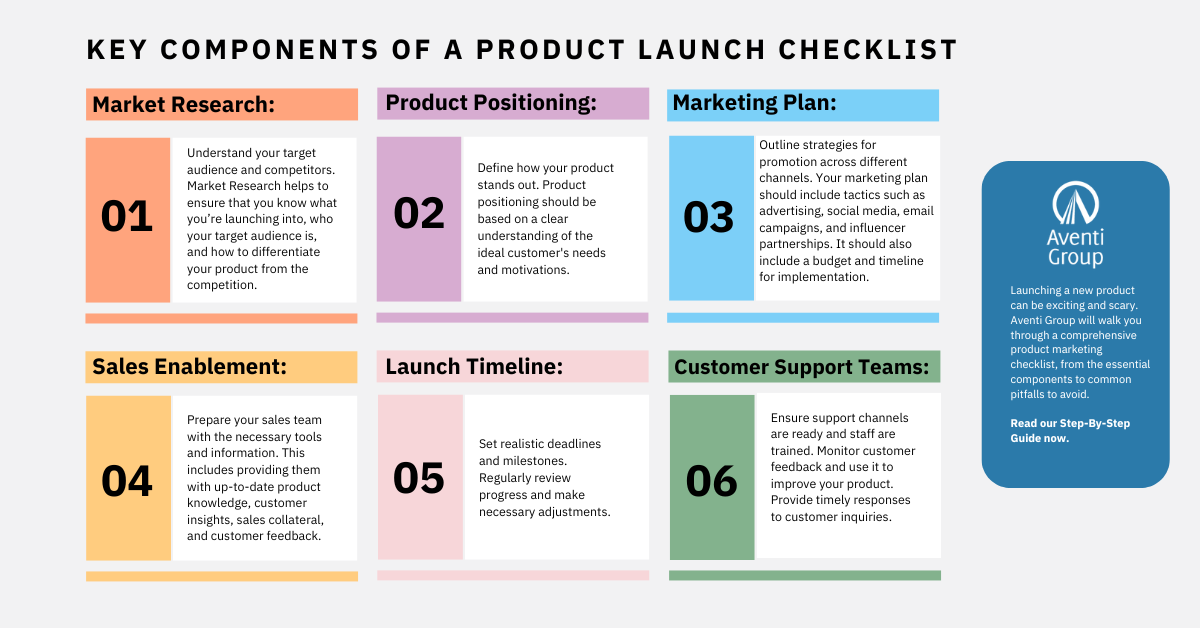Product Launch Checklist: A Step-By-Step Guide
Product Launch Checklist: A Step-By-Step Guide
Launching a new product can be exciting and scary. Without proper planning, your product launch could fail to reach its target audience or, worse, launch with critical flaws. To avoid this, you need a product launch checklist to ensure every detail is perfect and nothing is overlooked.
In this blog, we’ll walk you through a comprehensive product marketing checklist, from the essential components to common pitfalls to avoid, ensuring your next product launch is smooth and effective.

Why You Need a Product Launch Checklist
A well-structured product launch checklist is invaluable. Here’s why:
- Ensures thorough preparation: A checklist guarantees all essential steps are covered, from market strategy to post-launch analysis.
- Saves time: Checklists help ensure nothing important is overlooked. You will also have a clear timeline, and all tasks will be done on time.
- Improves outcomes: A checklist can help identify potential risks and opportunities, helping to ensure a successful launch.
- Streamlines communication: Keeps every team member on the same page, ensuring a unified approach to the launch.
- Measures progress: Helps you track what has been done and what still needs attention, preventing last-minute rushes.
Without one, you risk:
- Missed opportunities: Without a structured plan, you might overlook crucial marketing channels or audience segments. For instance, if you don’t create a plan for using social media to reach your target market, you could miss out on valuable opportunities to connect with potential customers.
- Wasted resources: Time and money are squandered on uncoordinated efforts that don’t contribute to launch goals. For example, if a company launches a new product without a marketing plan, it may spend money on advertising that doesn’t work or on creating unclear and ineffective content.
Damaged reputation: A poorly executed launch (such as inconsistent messaging) can impact your brand image and customer trust. For example, if a company launches a product to market without testing it first, it may get complaints and negative reviews, damaging its reputation.
Key Components of a Product Launch Checklist
Let’s explore the key elements of product marketing. A comprehensive product launch checklist should include the following:
- Market Research: Understand your target audience and competitors. Market Research helps to ensure that you know what you’re launching into, who your target audience is, and how to differentiate your product from the competition. It also helps to make sure that the product launch is successful and that it reaches the right people.
- Product Positioning: Define how your product stands out. Product positioning should be based on a clear understanding of the ideal customer’s needs and motivations. It should also include a clear messaging strategy to communicate the features and benefits of your product.
- Marketing Plan: Outline strategies for promotion across different channels. Your marketing plan should include tactics such as advertising, social media, email campaigns, and influencer partnerships. It should also include a budget and timeline for implementation. Last but not least, you should have a conversion rate measurement strategy.
- Sales Enablement: Prepare your sales team with the necessary tools and information. This includes providing them with up-to-date product knowledge, customer insights, sales collateral, and customer feedback. Sales teams should also have access to CRM systems to track customer interactions and measure performance. Finally, provide sales teams with training and support to help them succeed.
- Launch Timeline: Set realistic deadlines and milestones. Regularly review progress and make necessary adjustments. Celebrate successes and reward team members for their hard work.
- Customer Support Teams: Ensure support channels are ready and staff are trained. Monitor customer feedback and use it to improve your product. Provide timely responses to customer inquiries. Develop a customer feedback system to measure customer satisfaction.
From understanding your market to effectively selling your product, each component is essential for a successful product launch process.
Creating Your Product Launch Checklist
To create an effective product launch plan checklist:
- Start with broad business objectives: Identify your main goals for product marketing. One smart goal might be to reach X number of new users.
- Break down into actionable tasks: List specific actions needed to achieve each objective. For instance, to reach X number of new users, you could create a targeted social media campaign, send out a press release, or launch a promotional campaign.
- Assign responsibilities: Make sure every task has an owner. For instance, you could assign the social media campaign to your marketing team, the press release to the PR department, and the promotional campaign to the marketing department.
- Set deadlines: Establish a timeline for each task, ensuring a smooth flow towards launch day. For example, you could assign the marketing team two weeks to create a social media campaign, the PR department two weeks to create a press release, and the marketing department two weeks to create a promotional campaign.
These steps help create a roadmap tailored to your product launch, guiding your team from conception to market introduction.
Tips for Success
- Prioritize tasks: Focus on what will have the most significant impact first. This will help you stay focused and productive, as you’ll be able to deal with the most important things first.
- Be realistic with timelines: Allow for flexibility to adjust as needed. Break large tasks down into smaller, more manageable pieces.
Common Mistakes to Avoid
When utilizing your checklist, beware of:
- Overlooking market research: Failing to understand your broader audience can lead to misguided marketing efforts. For instance, a company might create a product without knowing what prospective customers want and need and then struggle to sell the product.
- Inflexibility: Be prepared to adapt your plan based on new insights or challenges. For example, a company might initially plan to launch a product in one specific market but decide to launch a product in other markets after realizing that the first market is not responding favorably.
- Ignoring internal feedback: Your team’s insights can be invaluable in refining the product before launch. Make sure to ask for feedback regularly and be open to making changes as needed.
- Neglecting post-launch plans: The work doesn’t stop once the product is out. Post-launch plans are essential for ensuring your product evolves and remains relevant. Have a plan for gathering and responding to user feedback. Without it, you will not know if your product meets customer needs.
Tools and Resources
Several tools can help you with your product launch strategy planning:
- Project management software: Such as Asana, ClickUp, or Trello, to keep track of tasks and deadlines.
- Digital marketing tools: Like Google Analytics and social media channels for promotion and engagement.
- Aventi’s templates and resources: For insights into effective product launch marketing strategies and more.
Conclusion
You need a well-crafted product launch checklist to guide your team through the complexities of launching a new product.
From initial market research to post-launch evaluation, pay attention to every detail. You want to make a lasting impact on the market, not just launch.
If you need help launching your product with precision, consider Aventi’s product marketing services. Let’s make your product launch a success.






